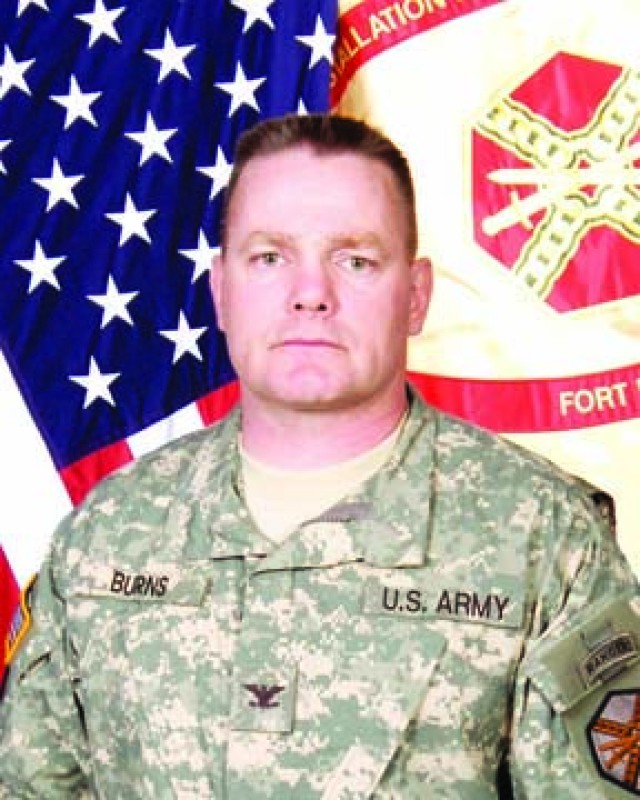FORT POLK, La. -- At Fort Polk's garrison "All Hands" brief Aug. 3, I laid out a plan that's going to take Fort Polk into the future: The Installation Management Campaign Plan, or IMCP, a road map that helps each Soldier, Family and civilian understand their role in supporting our Warriors now and in years to come.
In short, the IMCP tells us how we are going to provide unparalleled, standardized and measurable support to our Soldiers, Families and civilians. This support stresses well-being, mission readiness, infrastructure quality and quality of life services for all members of the Army Family.
I know you've heard this phrase or something like it before: "Our Soldiers and Families deserve a quality of life commensurate with the heroic service they've given this nation." The Installation Management Campaign -- with input from all of you -- is going to provide a lasting blueprint to providing those services.
The IMCP is focused around what we call "lines of effort," or LOEs, that define the facilities, programs and services required to support Army readiness, sustain the all-volunteer force and provide the infrastructure for current and future mission requirements. Those LOEs are:
Aca,!Ac Soldier, Family and Civilian Readiness
Aca,!Ac Soldier, Family and Civilian Well-being
Aca,!Ac Leader and Workforce Development
Aca,!Ac Installation Readiness
Aca,!Ac Safety
Aca,!Ac Energy Efficiency and Security
Weaving their way through each of these lines of efforts -- and tying them together -- are six themes:
Innovation: Introducing new things, launching new standards, breaking routines and ways of thinking. Innovation can be anything from a new service (like Army Community Service's Date Night) to a minor improvement to the way we do business (In and Out Processing). Many ideas for innovative change come from customers and front-line workers -- so speak up! We're listening!
Sustainability: What can we do more effectively' How can we do things today to save resources and continue in the future' For example, organizations throughout post might use the same type of color printer so we're not using 5,000 different types of toner. Not only is that cost effective now, but it will impact the environment later.
Resiliency: A person's ability to bounce back from change or misfortune. Individuals must be fit mentally, physically, and spiritually to achieve optimum resilience. Examples include programs and services such as Military Family Life Consultants, practical readiness classes, spiritual fitness and other counseling services.
Stewardship: Taking good care of the resources (money, people, and property) that we've been entrusted with by the American people. Examples of stewardship include repairing the training areas after an exercise, recycling, use of Individual Development Plans for employee development and performance improvement.
Cost-culture: Bottom line of cost-culture is spending taxpayers' dollars wisely. Funding cuts have forced us to look at our services and business practices to ensure that we are making the best decisions. How do we deliver a service -- in house or contract' How often do we replace computers' Are we maintaining the right number of vehicles in our fleet'
Partnerships: We must multiply our resources - expand the quality of life beyond the fence line into the outside community! Through the Community Covenants, we work with local communities and businesses to enhance the quality of life of Soldiers and Families. Plans are in the works for development along Hwy 467 including construction of a Veterans Administration Clinic and Cemetery. These projects are just a few of the many that are coming up both on and off post.
Implementing the IMCP isn't going to be as hard as you may think. Installation Management Command Commander, Lt. Gen. Rick Lynch, advises us to ask ourselves three questions when approaching the plan as a whole:
1. Are we doing the right things'
2. Are we doing things right'
3. What are we missing'
I have six more questions to add to those:
1. What do you do'
2. Who do you do it for'
3. How do you do it'
4. How well do you do it'
5. How do you know you're doing it well'
6. How good is that metric'
Keep those questions at the forefront of your approach to the IMCP. Those fundamental questions should be our guide.
You'll be reading more about each Line of Effort in coming issues of the Fort Polk Guardian. Those articles will offer information about the plan, but more importantly, they will outline why that information is important to you. I'll also be sharing with you a "personal vision statement" that can help you do what's right as we work together to implement this plan.
Each of you is a stakeholder in the IMCP. From battalion commander to new recruit; from organization director to a just-hired employee, each of you has ideas on how to make things better and feedback that we want to hear.
With each Guardian article about our LOEs, you'll be invited to share those ideas through e-mail, ICE, Facebook and more. With your input, each of you will help forge a better future for our installation and tomorrow's Army.


Social Sharing